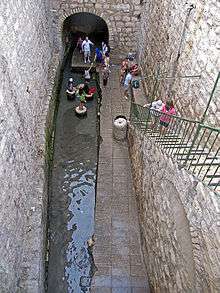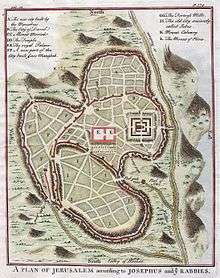Pool of Siloam

_p058_THE_POOL_OF_SILOAM.jpg)
The Pool of Siloam (Hebrew: בריכת השילוח, Breikhat Hashiloah) is a rock-cut pool on the southern slope of the City of David, the original site of Jerusalem, located outside the walls of the Old City to the southeast. The pool was fed by the waters of the Gihon Spring, carried there by two aqueducts.
History

The Pool of Siloam is mentioned several times in the Bible. Isaiah 8:6 mentions the pool's waters, while Isaiah 22:9-11 refers to the construction of Siloam tunnel.
For Christians, the Pool of Siloam has additional special significance: it is mentioned in the Gospel of John as the location to which Jesus sent "a man blind from birth" in order to complete his healing.[1]
A nearby pool, once thought to be the Pool of Siloam, was restored in the 5th century at the behest of Empress Aelia Eudocia in the Byzantine period. This pool survives to the present day, surrounded on all sides by a high stone wall with an arched entrance to Hezekiah's tunnel which was discovered in the 19th century.
The Pool of Siloam from the Second Temple was destroyed and covered after the First Jewish–Roman War in the year 70. Dating was indicated by a number of coins discovered on the stones of the patio near the pool to the north, all from the days of the Great Revolt. The latest coin is dated with "4 years to the day of the Great Revolt", meaning the year 69. In the years following the destruction, winter rains washed alluvial from the hills down to the valley and down the slopes of Mount Zion to the west of the pool; the pool was filled with silt layers (up to 4 m in some places) until it was covered completely.
While workers were installing a sewer system near the present-day pool in the autumn of 2004, Eli Shukron, an archaeologist of the Israel Antiquities Authority working nearby asked the tractors to stop in order to document and photograph the site. The first steps were discovered at this time. Shukron called his colleague Ronny Reich, to the scene, and both believed it was likely that they were part of the Second Temple period pool.
Lower pool

Ancient records report that during the Second Temple period, there was a lower pool. During a sewer excavating near the present-day pool by Ir David Foundation workers, in the autumn of 2004, Archaeologist Eli Shukron (working in the Israel Antiquities Authority) accompanied by the "Israel Nature and Parks Authority" Ori Orbach (who was asked to document in photographs the sewer excavation by Eli Shukron) uncovered stone steps, It became obvious to Eli Shukron and Ronny Reich (prominent archaeologists) that these steps were likely to have been part of the Second Temple period pool. Excavations commenced and confirmed the initial supposition; the find was formally announced on August 9, 2005, and received substantial international media attention.[2][3] The pool is less than 70 yards from the edge of the Byzantine reconstruction of a pool previously thought to be the Pool of Siloam. This small pool collected some of the water as it emptied there at the southern end of Hezekiah's tunnel. The water continued on through a channel into the recently discovered Pool of Siloam. The source of the water is from the Gihon Spring, located at the northern end of Hezekiah's tunnel on the eastern side of the City of David. An ancient pool (Upper Pool) once existed near the Gihon Spring but was no longer used after King Hezekiah redirected the waters to the western side of the city.[4]
The lower pool is not perfectly rectangular, but a soft trapezoid. There are three sets of five steps, two leading to a platform, before the bottom is reached, and it has been suggested that the steps were designed to accommodate various water levels. The pool is stone-lined, but underneath, there is evidence of an earlier version that was merely plastered (to help it retain water). Coins found within this plaster date from the time of Alexander Jannaeus (104–76 BC), while a separate collection of coins, dating from the time of the First Jewish–Roman War (AD 66–70), were also found.
How much of the pool and its surrounding structures were a result of monumental construction by Herod the Great is not yet understood (as of September 2006); nor is the relationship of this pool to the earlier one (i.e., why it was built when the earlier pool already existed). A portion of this pool remains unexcavated, as the land above it is owned by a nearby Greek Orthodox church and is occupied by an orchard known as the King's Garden (compare Nehemiah 3:15).
As a freshwater reservoir, it would have been a major gathering place for ancient Jews making religious pilgrimages to the city. The Gospel of John suggests that it was probably used as a mikvah (ritual bath),[5] although mikvahs are usually much smaller in size; if the pool were a mikvah, it would be the largest ever found by a substantial margin.[6] Yoel Elitzur has proposed that the pool was used for swimming rather than ritual immersion.[7] It is thought that the current structure was originally the Shrine of the Four Nymphs (Tetranymphon), a nymphaeum built by Hadrian during the construction of Aelia Capitolina in 135[8][9][10] and mentioned in Byzantine works such as the 7th-century Chronicon Paschale; other nymphaea built by Hadrian, such as that at Sagalassos, are very similar.[11]
See also
References
- ↑ John 9 cf. US Conference of Catholic Bishops, John, Chapter 9
- ↑ Archaeologists identify traces of 'miracle' pool. Siloam Pool was where Jesus was said to cure blind, AP, Dec. 23, 2004
- ↑ Rossner, Rena (January 26, 2006). "The once and future city". The Jerusalem Post. Retrieved November 15, 2009.
They have also discovered thousands of fish bones that, together with the bullae were found in an area that Reich and Shukran believe to be the Shiloah Pool, used as a ritual bath for the Temple Mount, and a tiled road which ends at the pool and has its origins near the Temple Mount. Ostensibly, this is the road that worshipers used to go back and forth between the Shiloah Pool and the Temple Mount.
- ↑ The City of David; revisiting early excavations; English translations of reports by Raymond Weill and L-H. Vincent/ notes and comments by Ronny Reich; edited by Hershel Shanks. Pages 197-227.
- ↑ John 9:6-11
- ↑ James H. Charlesworth, quoted in Los Angeles Times, article: Biblical Pool Uncovered in Jerusalem, 9th August 2005
- ↑ Yoel Elitzur (2008). "The Siloam Pool — 'Solomon's Pool' — was a swimming pool". Palestine Exploration Quarterly. 140 (1): 17–25. doi:10.1179/003103208x269114.
- ↑ Dave Winter, Israel handbook, (1999) p 180
- ↑ André Grabar, Martyrium, (1946), volume 1, page 193
- ↑ E. Wiegand, The Theodosian Monastery, (1929), volume 11, page 50-72
- ↑ for example, see this view
Further reading
- Elitzur, Yoel (2008). "The Siloam Pool — 'Solomon's Pool' — was a Swimming Pool". Palestine Exploration Quarterly. 140 (1): 17–25. doi:10.1179/003103208x269114.
- Reich, R.; Shukron, E.; Lernau, O. (2007). "Recent Discoveries in the City of David, Jerusalem". Israel Exploration Journal. 57: 153–168.
- Image and text of the Siloam inscription
- Shanks, Hershel (September–October 2005). "The Siloam Pool Where Jesus Cured the Blind Man". Biblical Archaeology Review. 31 (5): 16–23.. Click here for an abridged article in html or the full article in pdf format.
- Pictures of the recently rediscovered Pool of Siloam from holylandphotos.org
-
 Herbermann, Charles, ed. (1913). "Siloe". Catholic Encyclopedia. New York: Robert Appleton Company.
Herbermann, Charles, ed. (1913). "Siloe". Catholic Encyclopedia. New York: Robert Appleton Company. - Fuad Abu-Taa', Aliza Van Zaiden and Tsagai Asamain, Conservation of the Shiloah Pool and preparing it for the public , Israel Antiquities Authority Site - Conservation Department
Coordinates: 31°46′14″N 35°14′06″E / 31.77056°N 35.23500°E